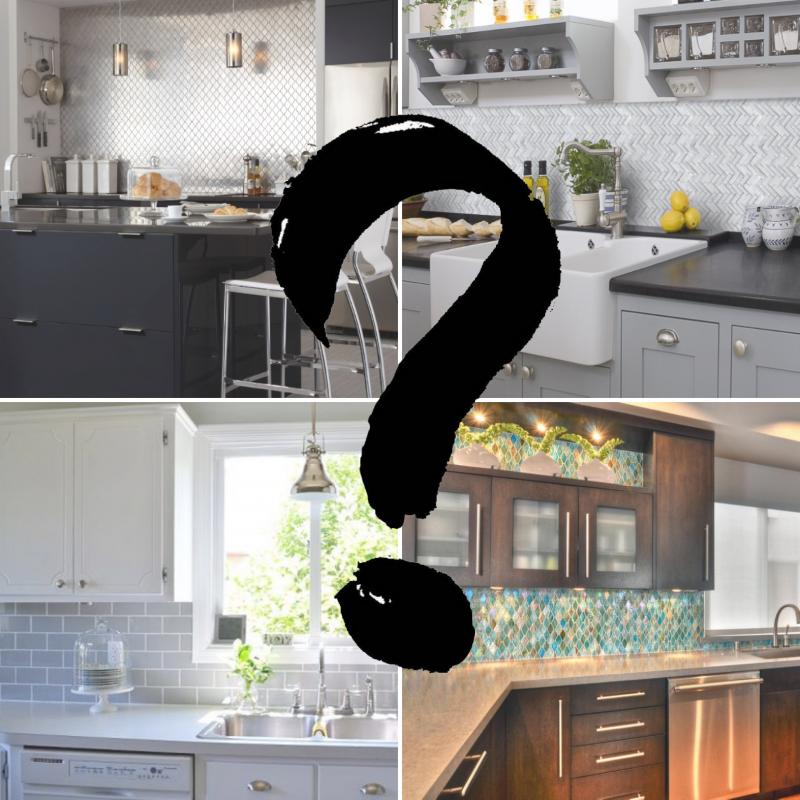
Your kitchen backsplash is one of those design details you’ll want to spend some time on. It may seem like a simple task, but choosing your backsplash can be complicated. There are a variety of things to consider that will affect your overall kitchen design. To help you out, and make sure you don’t miss anything, we’ve compiled a list of things you should contemplate when deciding on a backsplash. As there are always other considerations to make, we always suggest to consult with your designer, contractor, or one of our talented sales & design consultant before installing your tile.
1. What Colour?
Colour is usually one of the first decisions you’ll make. You’ll need to decide if you want your backsplash to be colourful, or if you want to remain in the neutral zone. Although a colorful backsplash has immediate impact, a neutral backsplash can add just as much character to your space. It all comes down to the other colors and materials being used in your kitchen and how your tile will pair, and your overall color preference. Some people are drawn to colour, while others find a sense of calm in a neutral space.
Having a tough time deciding between colours? Live with them for a while. Tape colour and tile samples to the walls to see what they look like throughout the day as natural light changes and with the lighting in that particular room. Choose one main colour and a couple of accent colours to use throughout the kitchen, including the backsplash.
2. Backsplash Height
Backsplash height is often a design detail home owners overlook. The backsplash has to end somewhere, but where it ends is up to you. Cabinetry can often be the deciding factor. If you just want a hint of tile, bring your backsplash up to the bottom of your cabinet only. If you want more tile, you can often extend your backsplash to the ceiling in areas where there are no cabinets, such as over the sink, or over a stove. A counter to ceiling installation makes the tile a focal point in your kitchen – so if you choose to bring it to the ceiling, make sure you’ve chosen a color, size and layout that you love.
3. Material
The material you choose for your backsplash is just as important as colour. You’ll need to figure out which tile type will work best in your overall design – ceramic tile, brick, stone, etc. This decision should be based on personal preference but also on the overall design style you are trying to achieve. If your kitchen is rustic or industrial, brick may work the best. If it is clean and contemporary, a crisp matte glazed ceramic tile will probably be your best bet.
4. Consider the Magic Formula (Consider Your Counter tops)
The floor, countertop and backsplash must all work together for your kitchen to have an even, balanced look. Keep in mind that the backsplash should not be treated as a separate entity to the overall space. All elements need to work to create an overall effect.
Your tile backsplash is always going to be right up against your countertops, so it is important to make sure the two work well together. For example, if you choose a colourful countertop material, you’ll want to choose a neutral tile colour (but you can still go wild with pattern!) If your countertops are neutral, choose tile that complements the texture and tone of the countertop material.
Try mixing metallic tiles in different shades with various finishes, such as brushed stainless steel, oil-rubbed bronze or even an antique brass in your back splash. By including small tiles of marble or granite, you can pull in the countertop colour without being boring with a panel of granite that extends up from the countertop, says Barrie Spang, interior designer at Lee Meier Interiors (Ohio).
5. Shape and Pattern
Do you prefer classic shapes, or fun patterns? –Another important decision to be made. If you want your kitchen to remain timeless in design, a classic field tile size such as a 3 x 6 in a subway tile layout, or even a 4 x 4 in a straight set pattern. Field tile will transcend trends, making your tile backsplash a sustainable design feature. However, if you are drawn to pattern, specialty shapes can be just as timeless when done right. As for glass tiles, check out some of the newer tiles with a bit of crackle or frosted finish. There’s also metallic patterns, different shapes (hexagons, linear, etc). Overall, you would want to ensure the colour and shape chosen fit well in your entire home and not just your kitchen.
6. Mix it Up
Add interest and combine different materials, like stone mosaics with glass tile. Try mixing it up and use of mosaics – for example, using Idyllic Blends by Daltile, which is a tile with the mixture of glass, stone and LVT. You can also try experimenting with shades of cement tiles to add dimension. Another way to mix things up, is to install a backsplash with different sizes of the same material. You’ll be surprised by what a little bit of variety will do for the design.
7. Budget
Last but not least, budget is one of the most important things to consider when choosing backsplash tile. If your budget is tight, you’ll want to lean toward standard field sizes. Nevertheless, you can still add fun details or a splash of colour with mosaics. Keep in mind that some specialty shapes and more intricate glazes do cost a bit more. When on a budget, one tip to try is to avoid trendy tile and revisit classic white ceramic that can be less expensive. Last tip? – Invest in a good grout. Colours and pattern trends come and go, but the grout is the backbone of your backsplash. “How the tiles adhere to the wall is important, so make sure you get a nice grout,” Spang says.



